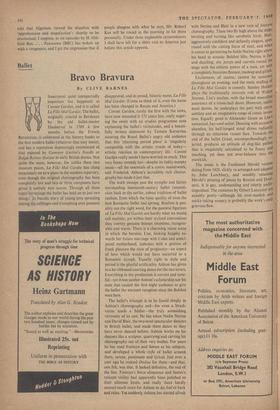Ballet
Bravo Bravura
By CLIVE BARNES SOMETHING quite unexpectedly important has happened at Covent Garden, and it is called La Fille Ma! G ardee. The ballet, originally created in Bordeaux by the old ballet-master Dauberval in 1789 a few months before the French Revolution, is celebrated in the history books as the first modern ballet (whatever that may mean), and has a reputation depressingly reminiscent of that enjoyed by Calmer Gurton's Needle or Ralph Roister Doister in early British drama. Not quite the same, however, for unlike these two museum pieces, La Fille Ma! Gardee has clung tenaciously on to a place in the modern repertory, even though the original choreography has been completely lost and two or three composers have given it entirely new scores. Through all these topsy-turveyings the ballet has held on to just two things : its bucolic story of young love sprouting among the cabbages and triumphing over parental disapproval, and its proud, historic name, La Fille Ma! Gardee. (Come to think of it, even the name has been changed in Russia and America.) Covent Garden, rarely the first with the news, have now mounted it 171 years late, coyly sugar- ing the sweet with an erudite programme note explaining the ballet's vicissitudes, and a beauti- fully written statement by Tamara Karsavina assuring the Royal Ballet's angry old audience that this 'charming period piece' is 'singularly compatible with the artistic trends of today— artistic reaction to contemporary life.' Covent Garden really needn't have worried so much. This very funny comedy has—despite its tinkly-tumpty music—all the essentials of a comic masterwork, and Frederick Ashton's incredibly rich choreo- graphy has made it just that.
The work swoops past the nymphs and fairies surrounding nineteenth-century ballet romanti- cism back to the earlier, robust tradition of ballet realism, from which the basic quality of even the best Romantic ballet had sprung. Realism is pos- sibly not the right word, for the pastoral figurines of La Fille Mal Gardee are hardly what we would call realistic, yet within their stylised conventions they convey genuine human emotions, recognis- able and warm. There is a charming mime scene in which the heroine, Lise, looking happily to- wards her future marriage with Colas and antici- pated motherhood, indicates with a gesture of frank pleasure the state of pregnancy—an aspect of love which would not have occurred to a Romantic nymph. Equally right in style and period is the playful artificiality Ashton has given to a be-ribboned courting dance for the two lovers. Everything in the production is correct and taste- ful—yet it was neither Ashton's scholarship nor his taste that caused the first night audience to give the ballet the warmest reception since the Bolshoi were here.
The ballet's triumph is to be found simply in Ashton's choreography and—for even a Stradi- varius needs a fiddler—the truly astonishing virtuosity of its cast. He has taken Nadia Nerina and David Blair, the two most spectacular dancers in British ballet, and made them dance as they have never danced before. Ashton works on his dancers like a sculptor, quarrying and carving his choreography out of their very bodies. For years he has used Fonteyn and Somes as his subjects, and developed a whole style of ballet around them, serene, passionate and lyrical. Just over a year ago he created Ondine for them—and that, one felt, was that. It looked definitive, the end of the line. Fonteyn's fierce eloquence and Somes's reticent virility had apparently been polished to their ultimate limits. and really there hardly • seemed much more for Ashton to do, but'sit back and relax. Yet suddenly Ashton has started afresh with Nerina and Blair in a new vein of bravura choreography. These tWo fly high above the stage, twisting and turning like aerobatic birds. Blair, aggressively confident and defiantly elegant, slims round with the cutting force of steel, and when it conies to partnering he holds Nerina right above his head in ecstatic Bolshoi lifts. Nerina is fast and dazzling; she jumps and curvets round the stage with the athletic power of a man, yet with a completely feminine flounce, madcap and girlish. Excitement, of course, cannot be sustained throughout an evening, and the main stuffing of La Fille Mal Gardee is comedy. Stanley Holden plays the traditionally travestie role of Widow Simone, Lise's mother, with the broad masculine assurance of a music-hall dame. However, unlike most dames, he underplays the part with clever subtlety and an imaginative range of comic inven- tion. Equally good is Alexander Grant as Lise's unwanted, hay-seed suitor. Dancing with eccentric abandon, his half-hinged mind shines radiantlY through an, otherwise vacant face. Towards the end of the ballet Grant, uncomprehendingly re- jected, produces an attitude of dog-like pathos that is exquisitely calculated to be funny and touching, yet does not over-balance into the mawkish.
The music is the Ferdinand Herold version dating from 1828, slickly re-arranged and adapted by John Lanchbery, and sensibly retaining Herold's pirating of pieces by Rossini and Dom- zetti. It is gay, undemanding and utterly undis- tinguished. The costumes by Osbert Lancaster are suitably pretty—although his over-modish and micky-taking scenery is probably the work's only grievous flaw.










































 Previous page
Previous page